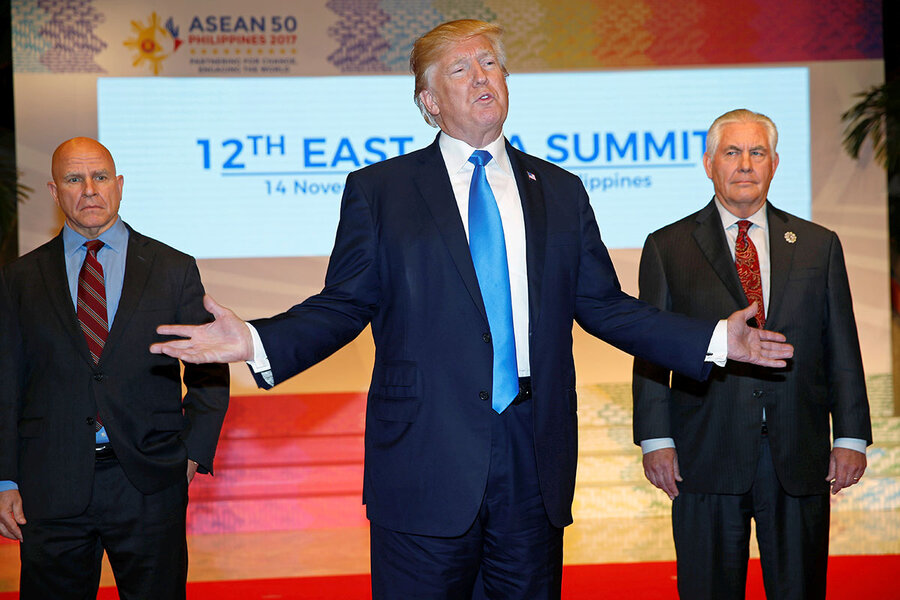White House turnover: the appeal and the risks for Trump
Loading...
National Security Adviser H.R. McMaster is about to lose his White House job. Except he’s not – or at least, he’s not getting booted yet. It’s Chief of Staff John Kelly who is on the way out, perhaps as soon as today.
Scratch that. Kelly and President Trump apparently have reached an understanding; he’ll stay for now. It’s cabinet secretaries such as Ben Carson of HUD and Scott Pruitt at EPA who are endangered. They’ll be first to go. Just as soon as that McMaster situation gets resolved.
As Mr. Trump heads into his second year in office, widespread and conflicting reports about upheaval among top White House and executive branch staff have created an air of turmoil and uncertainty in Washington as important decisions on tariffs, North Korea, and other big issues loom ahead.
Perhaps this is just as Trump wants it. It is a dramatic situation, as if the Oval Office were the center of a reality television competition. The multiple reports, from the Washington Post, the Wall Street Journal, the New York Times, and others, depict alternate staffing scenarios, as if different and competing White House factions are behind the different leaks.
This combines themes from Trump’s business past: skill in marketing and media management, comfort with change (some might say comfort with chaos), and tolerance for staff that argue among themselves. Most of all, it places him at the center, as the star of the show, the man who decides who does and doesn’t get fired.
Thus Trump’s impending (or not) staff reshuffling is entirely in keeping with the way he has run his life, says Chris Edelson, an assistant professor of government at American University.
“The lesson he probably takes from his life is, what I have done has worked out. But it has been a near miss,” says Mr. Edelson, citing the multiple times Trump businesses have gone bankrupt.
Extraordinary upheaval
As of mid-Friday afternoon none of the many alleged impending White House staff moves had come to pass, following Secretary of State Rex Tillerson’s dismissal Tuesday. National Security Adviser McMaster was still in place, despite his status as the person most rumored to be on the way out. Gen. McMaster’s military-style brusqueness and tendency to speak at length about issues has reportedly not endeared him to the president.
Trump may want to let the media settle down in the wake of Tillerson’s firing. In that sense, stories about possible personnel moves might be anti-predictive, actually making the change in question less likely to occur.
Indeed, the current White House has already seen record levels of staff turnover. For the first calendar year in office, turnover among “A” level White House personnel for the Trump administration has been triple the comparable figure for the Obama administration, and double that of the Reagan administration, according to figures compiled by Brookings Institution senior fellow Kathryn Dunn Tenpas.
Add in the moves made through early March of 2018, and Trump has a 43 percent turnover rate, Ms. Tenpas says. In contrast, Obama’s total turnover for the four years of his first term was 71 percent.
A focus on loyalty in hiring, and the general tumult of the first year of Trump’s administration, may have been the main reasons for the record turnover, according to Tenpas.
“It is not difficult to see why there may have been a great deal of turnover among the senior ranks,” she writes in an analysis of her data.
Pros and cons of turnover
While turmoil in the ranks isn’t good, sometimes it’s wise to get rid of people who aren’t working out. In that sense, it’s obvious that some of Trump’s firings may have made his administration more efficient.
Incoming administrations often fill key spots with top campaign aides who have proved their loyalty, says Matthew Dickinson, professor of political science at Middlebury College. But skill with campaigns doesn’t necessarily translate to skill at the difficult, political job of governance. In that sense, some of Trump’s high profile firings, such as his dismissal of strategist Steve Bannon, may have strengthened his team.
“I think Trump is learning on the fly,” says Dr. Dickinson.
But not all moves may have made the White House staff better. According to the Associated Press, Trump has recently told confidants that he needs to follow his own instincts more, and pay less heed to staff members who raise warning signs on particular policies or flat tell him “no.”
Presidents do need to maintain a diversity of opinion in their inner ranks, says Dickinson. In that sense, it would not be a good thing if Trump were just surrounding himself with an inner corps of “yes” staffers who will acquiesce in his impulsive moves.
“It is tough to hear somebody always disagreeing with you. The risk is you put yourself in an echo chamber,” Dickinson says.
Usually, presidential administrations face some turmoil in the first year as they weed out unsuitable appointees, then settle down for a period of stability. Some officials leave as mid-term elections approach, then the exodus grows as the end of a term nears. Working in the White House is exhausting under any president; appointees often want to get out and make some money from their experience while they can.
The Trump White House hasn’t yet reached that initial stable point. That may be putting things mildly – the backbiting and infighting has reached the point where news reports talk of rock bottom morale. The Washington Post report on McMaster’s possible transfer went so far as to say the mood in the White House now “verges on mania.”
That context puts all the leaks about personnel moves in an odd context, say some observers. “It’s almost like they’re a cry for help,” says Chris Edelson of American University.






